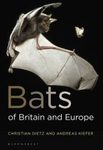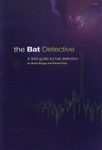Customer Reviews:
Book Review - 'British Bat Calls: A Guide to Species Identification' By Jon Russ
by Al Milano in the United States (05-03-2013). Read more at http://batdetecting.blogspot.com/
One does not need to be a resident of Britain, in order to appreciate and use this book. Which is the reason why I ordered a copy for myself. Although I live in the US, after some shopping around online, I decided to order my copy from NHBS. Unlike some online-shops in the US, they had new copies in stock, ready for shipping. And the price was reasonable (£29.99 | $46/€35 approx.)
I very quickly read through the first few pages. Followed by the Acknowledgments. And was utterly relieved to find that there were no references to any of the egocentric, stingy, American companies. Ahhh! What a relief! The same was true for the Preface section! And, I did read through it more slowly and carefully. Yay! I was so happy to learn that I could now proceed, free & clear.
I'll state right up front, that I found this book wonderful and refreshing. And it has required quite a bit of effort on my part to keep this review brief! This review could have easily ended up being four pages in length. I try to keep all of my book reviews brief.
Next up, was Chapter 1 - Introduction.
Among other topics, this chapter provides a short explanation of the discovery and history of bat echolocation.
Chapter 2 - Bats and sound
Provided very useful, and easy to understand descriptions of the properties of sound. The Author did a wonderful job of clearly explaining the various facets of sound, along with the "how's and why's"of bat calls.
Chapter 3 - Equipment
This section covered the subject of bat detectors :) And succinctly explained just about everything you'd want to know about them. Several other topics were related, including the various methods of recording bat calls.
Chapter 4 - Call analysis
How to use and understand sound analysis software. Very informative coverage of this topic, discussed in several parts. This chapter alone, is worth the price of admission. (I know that it may be an old adage, but I enjoy this book more with each chapter I read)
Chapters 5 and 6 - Species echolocation guide and Species identification
These particular chapters may not be very useful to me (since I live in the US), but the information they contain – On each species covered, is simply amazing. Chapter 6 alone, makes this book a must have for any bat enthusiast residing in the UK.
It's safe to say, that I own many books on the subject of Bats. And, I'm also planning to review a few of them here soon. I can state here and now, (with certainty) that this book surpasses the others on it's overall (up-to-date) content, and execution.
In conclusion, the book is very well laid-out. It's very informative, and a fantastic reference, to re-visit again and again! ...Now if only a bat expert from the US (of Jon Russ' caliber) would publish a book similar to it (for North American species)...And soon! I'd be very happy!
Editorial reviews:
"[...] If you are a casual user of a bat detector this book will be helpful in that it gives detailed descriptions of the frequencies and what you should hear for each species but the detail will probably be overkill. If you are seriously interested in bat calls this is certainly the book to use since, despite the little niggles, it is inclusive, detailed and very clearly written and organised."
– Peter Thomas, British Ecological Society Bulletin, August 2013
"The author's interest in bats began in the late 1990s when he was working on a PhD investigating the community composition, habitat associations and ultrasound of Northern Ireland's bats, an interest which was to develop into more than 20 years' involvement in bat research and conservation, the founding of a specialist bat consultancy, and work on many UK and European bat projects. Over these years, Jon Russ has compiled all the information, techniques and technology he has used, from the species notes used to help with bat identification to his accumulation of recordings of echolocation calls and social calls of British bats. This book, written with contributions from other bat conservation experts, is an attempt to bring all this together, presented and written at a level that is accessible to the wide range of people interested in bats, from voluntary bat group workers and researchers to the growing number of bat consultants. It has, indeed, achieved this aim. It is up to date, practical, thorough and yet also concise – and a handy size to fit in the rucksack.
The opening chapter explains the physics of sound, how bats generate ultrasound and use it to interpret the world around them, to locate and catch insects, and to communicate with each other, whether it be "advertisement calls" (looking for a mate), defending a feeding area or distress calls. Next comes a look at the equipment needed. Here, the technically challenged among us might hesitate a little, but the three main types of bat detector – heterodyne, frequency division, and time expansion – are clearly described, including the advantages and disadvantages of each, and which is most appropriate for different situations. Recording bat calls is an essential element of bat surveys and research projects, and the next chapter explains how to record sound, different recording formats, sound recording devices and recording levels. Armed with the correct equipment, the next stage is to analyse the calls recorded, and this is where sonograms, oscillograms and power spectra come in. There is a growing range of sound analysis software now available to process the calls recorded so that they can be measured, compared and identified. This chapter guides us through the process of selecting calls for analysis, determine the call shape and call parameter and from this, how to identify the species. Finally, there is a useful species echolocation guide designed to indicate a possible species, based on echolocation call shape and the frequency.
The main part of the book is taken up with species identification. Once you have understood the basics of the technical side, and decided on your equipment, this will, for most readers, be the most frequently referred to section of the book. For each species there are distribution maps, emergence times and brief notes on flight, foraging behaviour and habitat, followed by information on echolocation calls and social calls. Calls are described in the context of the three different types of bat detectors available, and illustrated with sonograms in several of the most widely used software programmes (BatSound and AnaLookW) for comparison in the field.
Bat identification to a particular species through the analysis of calls is not always straightforward, as Jon Russ warns. Some species have calls that are similar in structure, social calls may be very variable even within a species, and cluttered environments can distort call recordings. But armed with this practical little book, researchers, surveyors and amateurs can go out into the night with the benefit of the knowledge and experience built up over the years by Russ and his colleagues."
– Andrew Branson, British Wildlife 24(1), October 2012






































